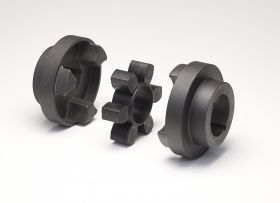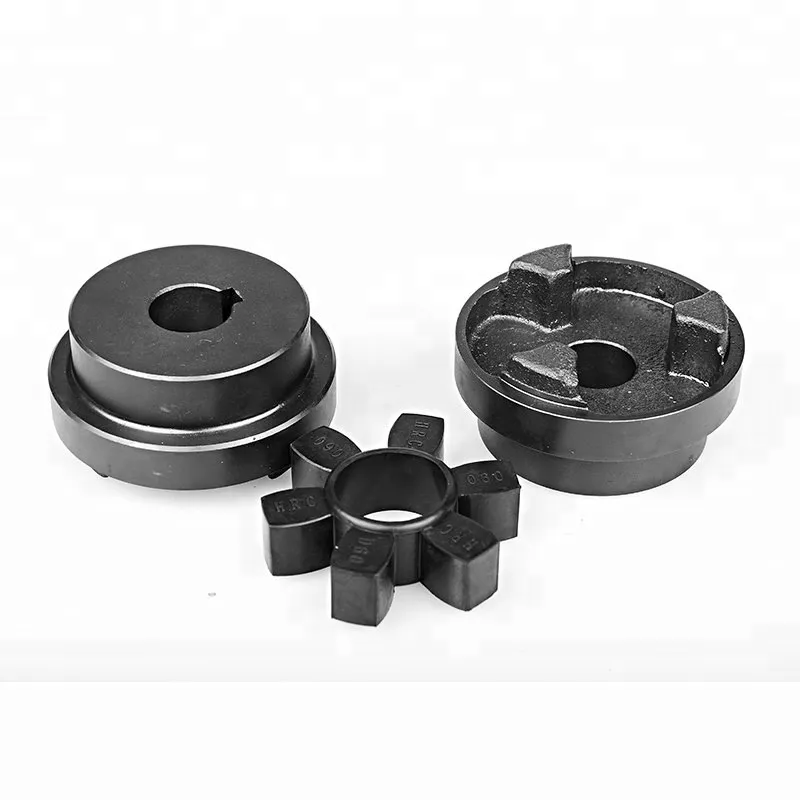Product Description
Product Description
HRC Flexible rubber shaft coupling types of spider coupling HRC B/F/H
HRC Coupling
· Installation is quick and easy without special tools required, only a hexagonal wrench is needed
· Maintenance is virtually eliminated without lubrication required
· The electro metric element allows HRC to be suitable for use in most conditions
· In the unlikely event of the flexible element being destroyed, drive will be maintained by inner action of the integrally cast driving dogs
Useful
Mainly used in the mining, metallurgical, cement, chemicals, construction, building materials, electric power, telecommunications, textiles, and transportation departments.
Such as:
Conveyor: Belt conveyor.AFC conveyor.Chain conveyor.Screw conveyor.
Pump: Water pump, oil pump, slush pump,etc
Fan: Draft fan,,fanner, boiler fan,etc
Excavator: Bucket excavator. Bucket wheel excavators.Bucket wheel stacker reclaimer.
Crane: Tower crane.Gantry crane.Bridge crane.
Others: Various elevators.Coal plough.Ball mill.Crusher.Recreation machine.Blender
equipment.Centrifuger.Washer.Leather-making machine.machine for recreation park
mixer wire drawing machine.Extruder,dregs crusher of boiler. Plastic feeder.Rubber
smelling machine.etc.
Product Parameters
Packaging & Shipping
Packing Details : Plastic bag + paper box+wooden case + wooden pallet
Delivery Details : 30-60 days after we received the payment.
Company Profile
About Mighty Machinery
ZheJiang Mighty Machinery Co., Ltd., specializes in manufacturing Mechanical Power Transmission Products. After over 13 years hard work, MIGHTY have already get the certificate of ISO9001:2000 and become a holding company for 3 manufacturing factories.
MIGHTY advantage
1, Abundant experience in the mechanical processing industries.
2,Large quality of various material purchase and stock in warhouse which ensure the low cost for the material and production in time.
3,Now have 5 technical staff, we have strong capacity for design and process design, and more than 70 worker now work in our FTY and double shift eveyday.
4,Strick quality control are apply in the whole prodution. we have incoming inspection,process inspection and final production inspection which can ensure the perfect of the goods quality.
5,Long time cooperate with the Global Buyer, make us easy to understand the csutomer and handle the export.
FAQ
Q1: Are you trading company or manufacturer ?
A: We are factory.
Q2:Do you provide samples ? is it free or extra ?
A: : Yes, we could offer the sample but not for free.Actually we have a very good price principle, when you make the bulk order then cost of sample will be return to you.
Q3: How long is your delivery time?
A: Generally it is 10-15 days if the goods are in stock. or it is 7-25 days if the goods are not in stock, it is according to quantity.
Q4:How long is your warranty?
A: Our Warranty is 12 month.
Q5 :Do you have inspection procedures for coupling ?
A:100% self-inspection before packing
Q6. What’s your payment?
A:1) 100% T/T. 2) 30% in advance, others before shipment. 3) L/C Q7:Can I have a visit to your factory before the order? A: Sure,welcome to visit our factory.
/* January 22, 2571 19:08:37 */!function(){function s(e,r){var a,o={};try{e&&e.split(“,”).forEach(function(e,t){e&&(a=e.match(/(.*?):(.*)$/))&&1
| Standard Or Nonstandard: | Standard |
|---|---|
| Shaft Hole: | 19-32 |
| Bore Diameter: | 10-100mm |
| Structure: | Jaw / Spider |
| Material: | Cast Iron |
| Type: | Flexible Coupling |
| Samples: |
US$ 26.6/Piece
1 Piece(Min.Order) | |
|---|
| Customization: |
Available
| Customized Request |
|---|


How do HRC Couplings Compare to Other Types of Couplings in Terms of Performance?
HRC (Highly Resilient Coupling) couplings offer specific advantages and disadvantages compared to other types of couplings, making them suitable for certain applications while not ideal for others. Here is a comparison of HRC couplings with some other common coupling types:
- HRC Couplings vs. Flexible Couplings: HRC couplings and flexible couplings both provide some degree of misalignment compensation and damping of vibrations. However, flexible couplings typically offer higher torsional flexibility and better misalignment accommodation than HRC couplings. HRC couplings may have limitations in terms of angular and parallel misalignment compared to certain types of flexible couplings.
- HRC Couplings vs. Gear Couplings: Gear couplings are more robust and can handle higher torque capacities than HRC couplings. They are suitable for heavy-duty applications that demand higher torque transmission and greater misalignment accommodation. However, gear couplings may be more expensive and less forgiving in case of misalignment.
- HRC Couplings vs. Disc Couplings: Disc couplings offer excellent misalignment compensation and torsional stiffness. They can handle high-speed applications and provide precise torque transmission. However, disc couplings are generally more expensive than HRC couplings and may require more frequent maintenance.
- HRC Couplings vs. Jaw Couplings: Jaw couplings are simple and cost-effective but offer limited misalignment accommodation compared to HRC couplings. They are suitable for light to moderate loads and lower torque applications.
Ultimately, the choice of coupling type depends on the specific requirements of the application. HRC couplings are well-suited for applications where moderate misalignment compensation is needed, and cost-effectiveness is a consideration. They are commonly used in pumps, compressors, conveyor systems, and other industrial machinery.
When selecting a coupling, factors such as torque capacity, speed, misalignment requirements, environmental conditions, and maintenance considerations should be taken into account. It is essential to consult with coupling manufacturers or engineering experts to ensure the appropriate coupling is chosen for optimal performance and reliability in the given application.

What Industries Commonly Use HRC Couplings for Power Transmission?
HRC (Highly Resilient Coupling) couplings are widely used in various industries for power transmission applications. Some of the common industries where HRC couplings are utilized include:
1. Manufacturing Industry: HRC couplings are extensively used in manufacturing plants for powering various machinery such as conveyor systems, pumps, compressors, fans, and machine tools. Their ability to dampen vibrations and accommodate misalignment makes them suitable for a range of manufacturing processes.
2. Petrochemical Industry: The petrochemical industry often employs HRC couplings in pumps, blowers, and agitators used for processing and transporting various chemicals and petrochemical products. These couplings help ensure smooth power transmission and protect equipment from shocks and vibrations.
3. Mining Industry: In the mining sector, HRC couplings are used in crushers, mills, conveyor belts, and other heavy-duty equipment. They are chosen for their durability and ability to handle high torque loads, which are common in mining operations.
4. Water and Wastewater Treatment: Water treatment plants and wastewater facilities utilize HRC couplings in pumps, mixers, and aerators to efficiently move and treat water and sewage. The couplings’ shock absorption capability helps reduce wear and tear on the equipment.
5. Power Generation: Power plants, both conventional and renewable, often use HRC couplings in generators, turbines, cooling tower fans, and other critical equipment. The couplings’ ability to handle high torque and dampen vibrations is beneficial in power generation applications.
6. Paper and Pulp Industry: In paper mills and pulp processing facilities, HRC couplings are employed in various stages of the manufacturing process, including pumps, agitators, and roll drives. They contribute to efficient power transmission and minimize downtime.
7. Steel and Metal Industry: The steel and metal processing industry relies on HRC couplings in rolling mills, furnaces, and other heavy machinery. These couplings assist in transmitting power effectively while absorbing shock loads and accommodating misalignment.
These are just a few examples, and HRC couplings find applications in numerous other industries, such as food and beverage, automotive, chemical, and construction, where reliable power transmission and protection of connected equipment are essential.

Explanation of Different Types of HRC Coupling Designs
1. HRC Standard Design: The standard or classic HRC coupling design consists of two cast iron hubs with a spider made of an elastomeric material, usually rubber. The hubs have teeth on the inner surface that mesh with the spider, providing torque transmission and flexibility. This design is commonly used in various industrial applications due to its simplicity and cost-effectiveness.
2. HRC Spacer Design: The HRC spacer coupling design is similar to the standard HRC design, but it includes a spacer between the two hubs. The spacer allows for more axial misalignment compensation and can accommodate longer distances between shafts. This design is suitable for applications where additional spacing between the shafts is necessary.
3. HRC Flywheel Design: The HRC flywheel coupling design is specifically used in applications where the coupling is mounted on a flywheel. The design incorporates a flywheel mounting hub on one side and a standard HRC hub on the other side. This allows the coupling to be easily connected to a flywheel for various engine-driven machinery.
4. HRC Taper Lock Design: The HRC taper lock coupling design includes taper lock bushings that enable easy installation and removal of the coupling from the shaft. The hubs have a tapered bore, and the taper lock bushings are inserted into the bore, providing a secure and precise connection to the shaft. This design is commonly used in applications that require frequent coupling removal and reassembly.
5. HRC Brake Drum Design: The HRC brake drum coupling design is used in applications where a brake is required. The design incorporates a brake drum on one of the hubs, allowing the coupling to serve both as a torque transmitting coupling and a brake drum for braking purposes. This design is commonly used in industrial machinery where controlled braking is necessary.
6. HRC Non-Spacer Design: The HRC non-spacer coupling design is similar to the standard HRC design but does not include a spacer. This design is suitable for applications where the shafts are relatively close together, and a spacer is not required for additional misalignment compensation.
7. HRC Stainless Steel Design: The HRC stainless steel coupling design is used in applications where corrosion resistance is essential. The hubs and spider are made of stainless steel, providing better resistance to rust and corrosion. This design is commonly used in industries such as food processing, marine, and pharmaceuticals.
8. HRC Pilot Bore Design: The HRC pilot bore coupling design is supplied with plain bore hubs, allowing the end-users to machine the bore to the required size. This design is beneficial when the shaft sizes are not standard or need to be customized for a specific application.
Overall, these different HRC coupling designs offer flexibility and versatility to suit various power transmission requirements across different industries.


editor by CX 2024-03-01
Leave a Reply